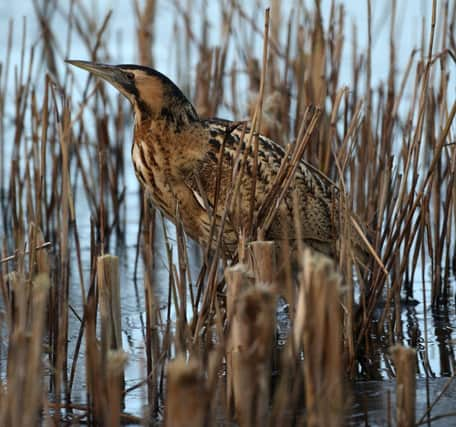Record results of booming bird on a comeback trail


But the elusive heron-like birds which were once extinct on these shores, has battled back from the brink thanks to committed conservation efforts like those put into action at Yorkshire Wildlife Trust’s Potteric Carr Nature Reserve in Doncaster.
According to new research by the RSPB, bitterns have enjoyed a record year in England with the highest number of individuals recorded since the 1800s.
Advertisement
Hide AdAdvertisement
Hide AdMartin Harper, the bird protection charity’s director of conservation, said their revival can be attributed in large part to funding from the European Union’s LIFE-Nature programme. The scheme has allowed a partnership of organisations including the RSPB to successfully create and restore wetland habitats for bitterns and other wildlife.
Mr Harper said: “Thanks to protection under European laws and key partners working together, bittern numbers have been gradually climbing since 2000.
“Bitterns needed conservation on a country-wide, landscape scale and without the support of the EU’s Birds Directive, which protects all European wild birds and the habitats of listed species like the bittern, this would not have been possible.
“The bittern success story should give hope that it is possible to recover threatened species and that it makes sense to protect the laws that protect nature.”
Advertisement
Hide AdAdvertisement
Hide AdRSPB scientist Simon Wotton added: “I’ve been working with bitterns for 10 years and it is wonderful to see how they have responded to the habitats we have restored for them. They’re amazing birds to watch so it is incredibly rewarding to see their numbers growing.”
Environment Secretary Elizabeth Truss said the bittern was “a truly special bird”, not least for its distinctive ‘booming’ call, and praised those responsible for conservation efforts to support it.
“This shows it is possible to reverse even serious declines in threatened species,” Mrs Truss said.
In Yorkshire, a key site for conservation work to aid the species has been Yorkshire Wildlife Trust’s Potteric Carr site.
Advertisement
Hide AdAdvertisement
Hide AdJim Horsfall, reserves officer for the wildlife spot, said bitterns were one of the species the nature reserve had been specifically designed to benefit.
“The ongoing management of Potteric Carr for bitterns has in fact been so successful in recent times that last year Yorkshire Wildlife Trust saw its first breeding bittern on site.
“For many years now the site has provided a home for overwintering bitterns and over the last couple of years some males started to stick around in the summer and carry out their ritual booming call for a mate.
“However it wasn’t until summer 2014 that a female also stayed throughout the year and returned the males attention. This was superb news for the nature reserve and all the staff and volunteers who have worked their over the years trying to get the habitat just right.”